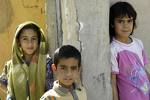Twelve Years Later: And How is Baghdad Today?

Comment: A multicultural city of peace for millennia has been conquered, divided and transformed in the 12 years since US invasion. But Baghdadis are resisting, says Haifa Zangana.
Two scenes from the fall of Baghdad in 2003 are burned into historical memory. The first is the choreographed toppling of Saddam Hussain’s statue in Firdos square by US marines, who covered it first with their flag. The second is the chaos of the looting of museums and state property.
The first was a declaration of military victory and “mission accomplished”. The second was a declaration of the start of the erasing of Iraqi culture, history and identity.
Baghdad was a microcosm of what befell Iraq as a whole, violated time and again by US troops, mercenaries, special forces, proxies and militias, scarred over and over by human and physical destruction.
It is a bitter irony for a city known historically as Madinet al Salam, the city of peace. Baghdad is seen by Iraqis as the ultimate symbol of their unity, their modernity and their multicultural identity.
Baghdad’s past glories – a diverse capital of science, arts and music at a time when Europe was crawling in the semi-darkness of Middle Ages – were in revival for much of the 20th century, despite the coups and the dictatorships. Then came the occupation.
Baghdad today is physically scarred by multiple checkpoints, concrete segregation walls and open sewers.
The checkpoints take two forms: those set up by the military, where men are subjected to sectarian harassment and women to sexual abuse, and those set up ad hoc by militias to kidnap, ransom and kill those they stop.
The post-invasion governments of Nouri al-Maliki and Haider al-Abadi have declared time and again that they are removing walls and checkpoints, but they remain to disfigure this city and torment its people.
Then there are the walls, usually concrete blocks at least three metres high. They exist, we have been told over time, to protect us from whatever threat fits the prevaling narrative: Saddamists, foreign fighters, al-Qaeda, the Islamic State group.
The US built many of these “security walls” as part of a “new strategy … to break the cycle of sectarian violence” and enable reconciliation between the capital’s Sunni and Shia, who had lived for centuries together in peace until after the invasion.
The US military chose not to mention that the walls have turned mixed communities into ghettos and gated areas populated almost exclusively along sectarian lines.
Divide and Conquer
It is no wonder the policy has been compared to Israel’s apartheid wall, and why Baghdadis came to see the structures as a method of control rather than protection.
This reality – checkpoints, walled ghettos, segregation and fear – is now ingrained and shreds the social fabric of the city. And despite this, the car bombs and attacks continue.
Corrupt politicians compound this manufactured reality – a reality that was never Baghdad and never should have been – with policies that promote segregation.
What of Baghdadis themselves? They continue to resist. Most of Baghdad’s residents are of mixed religion and ethnic background and cross-faith marriages persist only slightly less prevalent than before.
A long tradition of inter-communal cooperation between Sunni and Shia, Kurds, Turkmen and Arabs, Muslims and Christians, has survived.
Baghdadis are as resilient as ever in finding ways to defend their city, their way of life and to resist any policy that fragments identities in an attempt to control them. Baghdad has survived invasions, destruction and tyranny through the ages. It will do so again.

